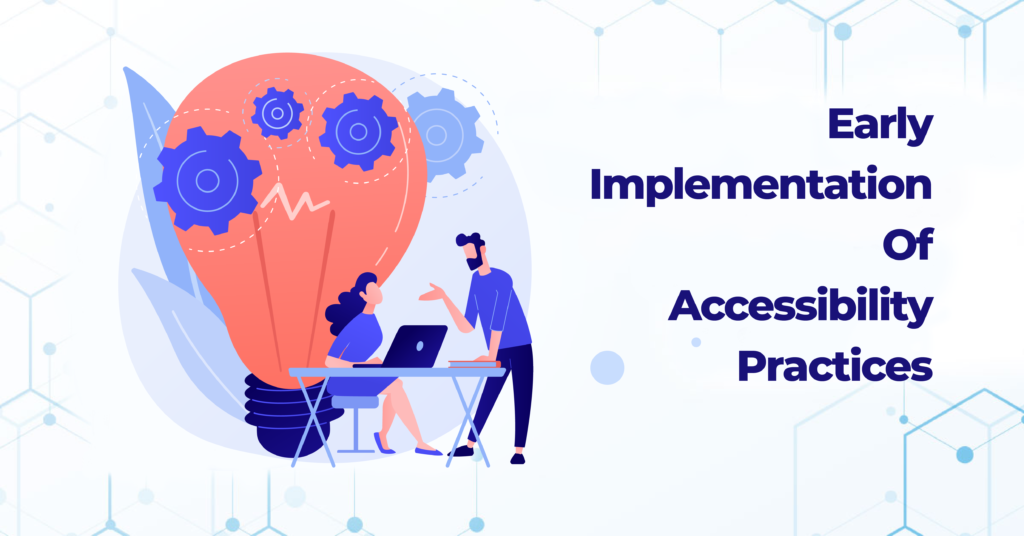With widespread technology comes the requirement to accommodate users with disabilities. In the search for complete accessibility, there has been a shift in focus to incorporate accessibility at early phases of software development.
Typically, accessibility audits are carried out during the quality assurance & user acceptance testing phases.
The key reason why the accessibility of a website deteriorates over time is due to the misconception that accessibility is a one-time thing opposing accessibility adoption at the early stages of the Software Development Life Cycle (SDLC).
One of the traditional SDLC approach used in software development is the Waterfall Model, which illustrates the software development process in a sequence of rows, meaning that if the previous phase is complete only then the next phase will start. Consequently, the release is delayed until fixed.
Shift Left Testing:
A Shift-Left software testing can be thought of as a line of the development cycle from left to right. Traditional testing used to be carried out on the far right of the line, which meant directly at the end of SDLC projected challenges such as increased costs, expanded time to market, unexpected errors.
Carrying out testing operations earlier in the software delivery process is called Shift Left.
A Shift Left practice detects defects early in the software delivery process.
Shift Left Accessibility Practice:
Accessibility is generally checked at the end of the SDLC or sometimes even after deployment. Due to this, the common issues faced are delays in release, increased development time, errors at unexpected points, and not being (accessible enough) for people with different challenges.
Using the Shift Left approach, accessibility tests are carried out at each stage of the SDLC; this limits accessibility-related bugs. Taking accessibility tests into respect, the tests are carried out at early stages viz. Planning, Analysis, Design, Implementation, Testing, and Maintenance.
Importance of early implementation of accessibility tests:
Studies indicate a substantial increase in the software budget when developed concerning the traditional SDLC. Accessibility tests carried out at the last phase of the SDLC often create more gaps in making the application or a website more accessible. Certain parameters are put forth to implement accessibility, but yet there is a major scope for loss of time, loss of resources, and coding complications. If accessibility is followed at each stage of the SDLC, any phase can be edited in the future without notable complications.
The implementation of accessibility tests at the early stage makes user success more likely. It is often advisable to include real users (disabled, older, and other users) throughout the development process to conduct mock test on various stages of our prototype to assure no glitches during the deployment; thus, ensuring accessibility integration from the very start while providing stakeholders a sharper perspective throughout the course of website development.
The website may face the following challenges while retrofitting if accessibility is not incorporated during the early stages of the development cycle:
- Color – It directly relates to Color Vision Deficiency (CVD), also known as color blindness. Certain color spectrums are known to be less suitable for the visually impaired, hence if we adhere to the accessibility guidelines from the designing stage, it saves us from the pain of disrupting the entire color theme at the end while retaining additional costs. Dark color themes are usually preferred.
- Design – If we are not considerate enough to accommodate the accessibility guidelines in the initial planning stage that not only includes developers but also designers and content providers; it again results in redevelopment and retesting issues that not only incur expense but also drains a lot of time. Evaluating early design prototypes, keeping colors, font sizes and interface design in check, helps us to validate the design aspects that work well, and to find the potential accessibility barriers while it is still inexpensive to fix them.
- Delay to Publish – Besides the gratifying idea to ensure web inclusivity, there lies a set of legal requirements that must be met. The failure to do so may result in the filing of hefty lawsuits.
The most durable way to meet long-term accessibility and the quality standards, is to ensure accessibility knowledge is incorporated in the organization and is subject to updation as roles change. Accessibility is not a one-time thing and requires regular checks as new features are added or redesigning takes place.
Conclusion:
Accessibility is one of the most important aspects of software yet there lies some ignorance in implementation.
Accessible software is easier to access and hence likely to reach more mass. It is essential to implement accessibility practices at an early stage so that the accessibility complications are eroded till the SDLC reaches its end while saving on the project budget if implemented at later stages.

